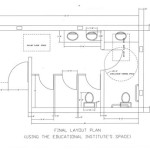How to Get Rust Off Your Bathroom Sink Drain
Rust commonly forms on bathroom sink drains due to constant exposure to water and humidity. The iron in many drain components reacts with oxygen and water, creating iron oxide, which is the reddish-brown substance known as rust. If left untreated, rust can not only be unsightly but can also weaken the drain, potentially leading to leaks and other plumbing issues. Removing rust promptly and effectively is crucial for maintaining the integrity and appearance of your bathroom sink.
Before commencing any rust removal procedure, safety precautions are paramount. Always wear rubber gloves to protect hands from cleaning solutions and potential contaminants. Ensure adequate ventilation in the bathroom by opening windows or turning on the exhaust fan. If using chemical rust removers, carefully read and follow the manufacturer's instructions, paying close attention to any safety warnings. Consider wearing eye protection to prevent splashes from irritating or damaging the eyes.
Key Point 1: Identifying the Type and Severity of Rust
Before selecting a rust removal method, it's important to assess the type and severity of the rust. Surface rust, which appears as a light coating on the drain, is generally easier to remove. Pitting rust, which penetrates deeper into the metal and creates small pits or indentations, requires more aggressive treatment. Distinguishing between these types will determine the most effective approach.
The material of the drain also plays a role in choosing the appropriate cleaning method. Chrome-plated drains, for instance, are more sensitive to abrasive cleaners than stainless steel or cast iron. Using harsh chemicals or abrasive tools on chrome can damage the finish, resulting in further corrosion. Careful consideration of the drain material is essential to avoid causing additional damage.
A visual inspection of the drain area is the first step. Look for the color of the rust, its texture, and how deeply it seems to be embedded in the metal. Light, orange-tinted rust usually indicates a surface issue. Darker, more textured rust suggests a deeper penetration. Noting the extent of the rust will help in selecting the appropriate tools and cleaning agents.
Once the severity and the type of rust are identified, one can move on to selecting the appropriate rust removal strategies.
Key Point 2: Implementing Various Rust Removal Methods
Numerous methods can effectively remove rust from bathroom sink drains, ranging from natural solutions to commercial rust removers. The choice depends on the severity of the rust, the type of drain material, and personal preference.
Natural Rust Removal Methods:
*
Vinegar:
Vinegar is a mild acid that can dissolve rust. Soak a cloth or sponge in white vinegar and apply it to the rusted area. Allow it to sit for at least 30 minutes, or even overnight for stubborn rust. After soaking, scrub the area with a non-abrasive scrubbing pad or an old toothbrush. Rinse thoroughly with water. The acidity of the vinegar breaks down the rust, making it easier to remove. It's a gentle and environmentally friendly option, particularly effective for surface rust. For areas that are difficult to reach, consider soaking a paper towel in vinegar and wrapping it around the affected area.*
Baking Soda:
Baking soda is a mild abrasive that can help lift rust. Create a paste by mixing baking soda with water until it forms a thick consistency. Apply the paste to the rusted area and let it sit for several hours. Use a scrubbing brush or sponge to scrub the area, and then rinse with water. Baking soda not only helps to remove rust but also deodorizes, leaving the drain smelling fresh. The gentle abrasive nature of baking soda makes it suitable for sensitive drain materials.*
Lemon Juice and Salt:
The citric acid in lemon juice, combined with the mild abrasive action of salt, can also be effective. Sprinkle salt over the rusted area, then squeeze lemon juice over the salt. Let the mixture sit for a few hours, and then scrub with a brush or sponge. Rinse thoroughly with water. This method is particularly useful for smaller areas of rust and is a natural alternative to chemical cleaners. The acidity of lemon juice helps to dissolve the rust, while the salt aids in the scrubbing process.*
Potato and Dish Soap:
This unconventional method works because potatoes contain oxalic acid, which helps dissolve rust. Cut a potato in half, then rub the cut side over the rusted area. Add a bit of dish soap to the potato for extra cleaning power. Let it sit for a few minutes, then scrub with a brush or sponge. Rinse with water. The oxalic acid in the potato reacts with the rust, loosening it from the drain surface. This method is gentle and non-toxic.Commercial Rust Removal Products:
*
Chemical Rust Removers:
Numerous commercial rust removers are available in liquid, gel, or spray form. These products typically contain stronger acids or chemicals that dissolve rust more quickly. Always follow the manufacturer's instructions carefully when using chemical rust removers. Wear gloves and eye protection, and ensure adequate ventilation. Apply the rust remover to the affected area, let it sit for the recommended time, and then scrub with a brush or sponge. Rinse thoroughly with water. Chemical rust removers can be highly effective, but they can also be harsh on certain materials, so testing on an inconspicuous area is recommended.*
Rust Converter:
Rust converters contain chemicals that react with rust, transforming it into a stable compound that can be painted over. Apply the rust converter to the rusted area, let it dry according to the manufacturer's instructions, and then paint the treated area with a rust-resistant paint. This method is suitable for areas where rust is severe and cannot be completely removed. The converter stops further corrosion and provides a protective barrier.Tools for Rust Removal:
*
Non-Abrasive Scrubbing Pads:
These pads are effective for scrubbing away rust without damaging the drain surface. Use them with any of the cleaning solutions mentioned above. *Old Toothbrush:
An old toothbrush is ideal for reaching tight spaces and crevices around the drain. *Steel Wool (Fine Grade):
For stubborn rust, fine-grade steel wool can be used carefully on durable drain materials like stainless steel or cast iron. Avoid using steel wool on chrome-plated drains as it can scratch the finish. *Rust Eraser:
Rust erasers are specialized tools designed to remove rust spots without scratching the underlying surface. They are particularly useful for removing small areas of rust on chrome or stainless steel.Selecting the right method involves considering the severity of the rust and the drain material. For light surface rust, natural methods may suffice. For more severe rust, commercial rust removers or rust converters may be necessary. Always proceed with caution and test any cleaning solution on a small, inconspicuous area first to ensure it does not damage the drain.
Key Point 3: Prevention and Maintenance
Preventing rust formation is often easier than removing it. Implementing regular maintenance practices can significantly reduce the likelihood of rust developing on bathroom sink drains.
Regular Cleaning:
* Regularly clean the bathroom sink and drain area with a mild soap and water solution. Wipe down the drain after each use to remove excess water and prevent moisture buildup, which encourages rust formation. A simple routine of wiping the drain area dry after each use can significantly minimize the exposure of metal parts to water, greatly inhibiting the formation of rust. It is a simple yet effective measure that requires minimal effort.
Proper Ventilation:
* Ensure adequate ventilation in the bathroom to reduce humidity levels. Use the exhaust fan during and after showers or baths to remove excess moisture from the air. Good ventilation helps to keep the drain area dry, making it less conducive to rust formation. If a bathroom lacks an exhaust fan, consider opening windows and the door to create airflow after showering or bathing.
Protective Coatings:
* Apply a rust-resistant coating to the drain. Several products are available that create a protective barrier against moisture and prevent rust from forming. These coatings can be applied after cleaning and drying the drain thoroughly. Select a coating specifically designed for bathroom fixtures to ensure compatibility and long-lasting protection. Such products prevent direct contact of the metal with water and air, effectively curbing the process of oxidation that leads to rust.
Addressing Leaks Promptly:
* Repair any leaks in the sink or drain immediately. Even small leaks can cause moisture to accumulate around the drain, accelerating rust formation. Regularly inspect the area underneath the sink for any signs of leaks and address them promptly. A leaking faucet or drainpipe provides a constant source of moisture that can lead to rust and other plumbing issues. Addressing these leaks promptly prevents further damage and minimizes the risk of rust formation.
Using a Water Softener:
* If hard water is a problem in the area, consider installing a water softener. Hard water contains minerals that can contribute to rust and corrosion. A water softener removes these minerals, reducing the risk of rust formation.
Regular Inspection:
* Periodically inspect the drain for signs of rust or corrosion. Early detection allows for prompt treatment and prevents rust from becoming a major problem. A simple check of the drain area every few months can help in identifying potential issues before they escalate.
By implementing these preventive measures, one can significantly reduce the likelihood of rust formation on the bathroom sink drain, ensuring its longevity and maintaining its appearance. Consistent maintenance is key to preventing rust and keeping the bathroom fixtures in good condition.
In summary, removing rust from a bathroom sink drain requires careful assessment, appropriate cleaning methods, and consistent maintenance. By understanding the type and severity of the rust, selecting the right cleaning agents and tools, and implementing preventive measures, one can effectively combat rust and maintain the integrity and appearance of the bathroom sink drain. Regular attention and proactive measures are crucial for preserving the life and functionality of the plumbing fixtures.

How To Replace A Rusty Sink Drain Howtolou Com

How To Remove Rust Stains From Sink Tub Mr Handyman

How To Remove Rust Stains From A Porcelain Tub Or Sink Cabana State Of Mind

How Did I Get Rust Stains In My Sink Benjamin Franklin Dallas

Here S How To Remove Rust Stains From Your Bathroom

Help Rust In Sink Hometalk

How To Remove Rust Stains From Toilets Tubs And Sinks

How To Remove Rust Stains From A Porcelain Sink

What Can I Do With Spot Of Rust On The Chrome My Bathroom Sink Hometalk

How To Remove Rust From Stainless Steel Advice Bob Vila
Related Posts







